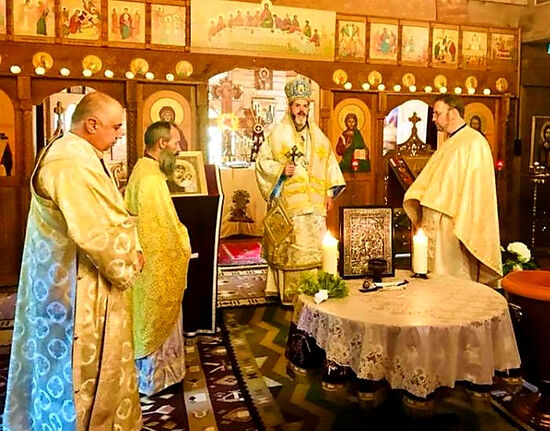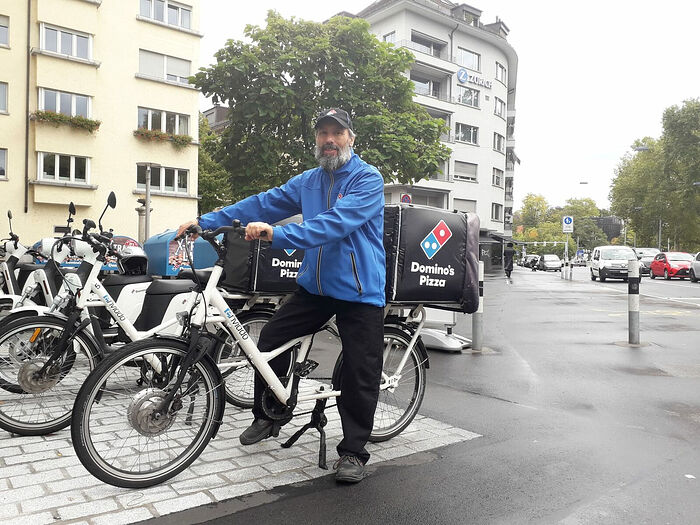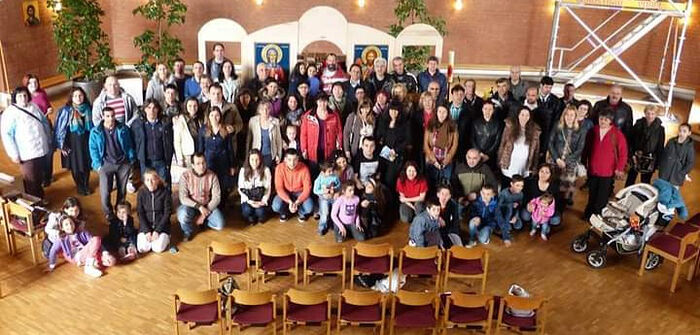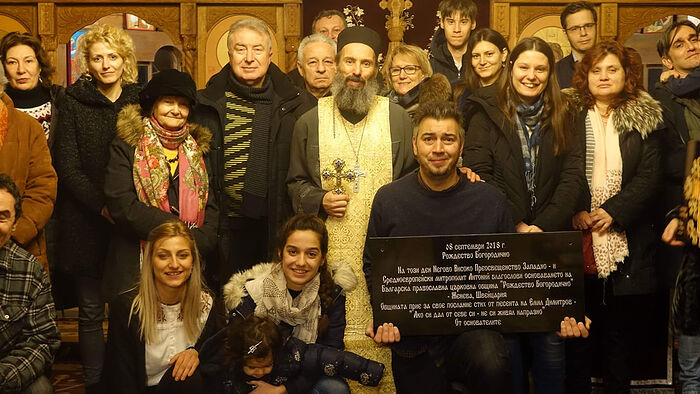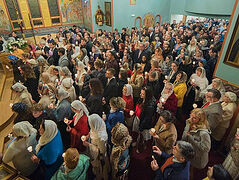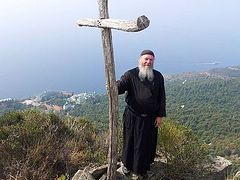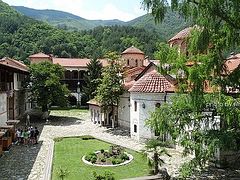Archpriest Jordan Pashev studied art in Bulgaria and became an iconographer. He has prepared for friendly debates about the faith with Evangelicals and he prepared for seminary entrance exams. Today he pastors a community of Orthodox Bulgarians in Nuremberg and others elsewhere, restores paintings and icons, and … delivers pizza.
We spoke with Fr. Jordan, the rector of the community of St. Theodosy of Tarnovo, about the life of a priest of the Bulgarian Orthodox Church in Europe.
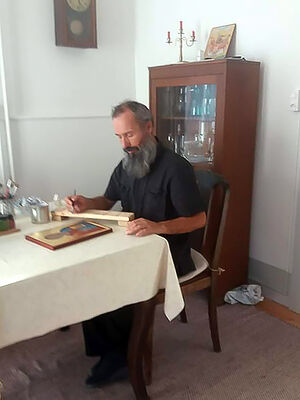 —You were born in the Bulgarian city of Pazardzhik. How did it happen that you left your homeland and now pastor parishes of the Bulgarian Orthodox Church in several European countries at once?
—You were born in the Bulgarian city of Pazardzhik. How did it happen that you left your homeland and now pastor parishes of the Bulgarian Orthodox Church in several European countries at once?
—In 1999, they were looking for artists to paint a church in Germany. I was chosen to work on a team with one fresco artist from Bulgaria and one from Hungary. I was ordained as a priest much later, when I already had a family.
—You graduated from art school in Plovdiv and were obviously planning to have a life in art. But how did the desire to become a priest arise?
—When I was studying in art school, I got interested in iconography. My friends thought it was pretty strange then, in the 1980s. There was a church being restored next to my house in ancient Plovdiv. I befriended the icon restorers and they let me help them. Thus, an interest in Church art arose within me. Later, when I was fulfilling my compulsory military service, there were some Evangelicals in my battalion. We would spend entire nights arguing about the faith. I started going to church on Sunday and talking with the priest so I could better prepare for my discussions with them. Amazingly, this is how I prepared myself for entrance exams to the theological academy in Sophia without knowing it.
—Painting icons is very important work. What style do you use? Do you try to emulate the iconographers of past ages, or are you more oriented towards later, perhaps even modern masters?
—I studied Church art at Veliko Tarnovo University for five years. They taught us all kinds of iconographic techniques and styles. Everyone developed their own preferences. You can learn a lot from the past, but for an iconographer, it’s important to touch the heart of modern man praying before an icon. We each went our own way. Some became fresco artists, others iconographers, and others, like me, priests. One guy from my class became a monk and now labors in the Bulgarian Zographou Monastery of St. George on Mt. Athos.
—As far as I know, you’re involved in restoring wall paintings in churches. Please tell us about the most memorable places you’ve worked and your impressions of what you were working with?
—I started working on restoring frescoes in the workshop of the late Bavarian master Herbert Eichner. He found me when I was painting frescoes in a church in Eichstatt. At the time, I wasn’t expecting it to become my main pre-ordination work. One of the most interesting places where I worked was the thirteenth-century Catholic cathedral in Freising. There were twenty restorers of different nationalities, and we worked for about two years. Pope Benedict was at the opening of the cathedral and we received letters of thanks from him. A year later, I got an order from the Pope to make an architectural model of the seminary where he studied. Then I was commissioned to make a copy of a twelfth-century icon for Cardinal Meisner of Cologne.
One of the most memorable objects was the monastic library in Straubing, where we cleaned the upper layers—an extremely delicate work that took a long time. Later the manager brought some machine that cleaned the dirt much faster, but there were great losses to the original. Fortunately, the commission decided to continue with the old tried and true method of millimeter by millimeter using a scalpel.
—Please tell us a little about the parishes you pastor. Which cities and churches? How large are the communities, and who are your parishioners?
—First I’ll tell you about the city of Nuremberg in Germany and the community of St. Theodosy of Tarnovo. The services are held in a Catholic church building and have continued this year according to schedule despite the epidemic and the renovation work on the building. I talk with my people online and on the phone every day. The city is very beautiful, with a rich history. It is the city of Albrecht Dürer, and also the city where Hitler’s headquarters were located.
I also pastor a parish in Majorca, Spain—the Church of the Great Martyr Zlata of Maglen—but I didn’t go there this year because of the COVID-19 pandemic. Previously, I would fly to the island often, to the roughly 10,000 Bulgarians living there. But today, alas, the situation does not allow it. The city is very beautiful, located on the Mediterranean coast of the largest of the Balearic Islands.
—Is it possible to organize activities for the communities outside of worship? If so, what kinds?
—Trips and pilgrimages, courses and seminars, and also theological discussions. They’re all intended for a wide range of people—young and old, beginners and advanced. I’ve been holding classes on iconography, wall painting, and other fine art techniques in Germany and Switzerland for fifteen years. What’s new is that everyone can participate in online classes now.
—And what do you do in between services? Do you have a secular job? What kinds of projects are you working on?
—In Germany, my main work was restoring frescoes. But my wife and two children and I have been living in Zurich for five years now. My wife and I have to work. Switzerland has a very high, and therefore a very expensive standard of living. During the week, I deliver pizza by bike for a major restaurant chain. Of course, I’m still painting icons and frescoes.
—In 2019, you earned a degree in intercultural theology from the University of Basel. In a nutshell, what was the essence of this major, and what was your purpose in studying it?
—One of the main problems for modern Europe is migrants from poorer countries. Many of these poor people believe in Christ. People’s cultural characteristics are formed largely under the influence of their faith. To help them integrate, we should first get to know them.
—Please tell us about the difficulties you regularly face in your priestly ministry, and any problems your parishes may have?
—That’s a long story… I began my ministry with great love and desire; I really tried. I was happy for every person who I managed to bring to the chalice. I believed this was my path. And success wasn’t long in coming. Within a few years, Church communities were organized in Nuremberg, Palma, Zurich, and Geneva. I wasn’t looking for any awards or praise for my work. People have trusted me with their suffering and their love, and this is my greatest reward. But then came the disappointments, and I was punished and suspended from serving for a while. It was very hard for me. Of course, I made mistakes. We all make mistakes. I’m more careful now; our trials are a lesson.
—Don’t you miss your homeland?
—And how! I still dream of the forests of the Rhodope Mountains, which I cherish in my childhood memories. And the rivers of the fertile Thrace and our Black Sea!... But over time, we get used to the place where we’re living, and when I tell my children about the homeland, I can see that they don’t feel it. They were born in Germany and grew up in Switzerland, and for them, Bulgaria is their ancestral homeland.
—As far as I understand, there is a catastrophic shortage of priests in the European parishes of the Bulgarian Church. Their primary task, of course, is to pastor the already existing communities, which consist mainly of compatriots. Does the Bulgarian Church, especially in the countries where your parishes are, carry out missionary work, and what kind?
—A priest’s main mission is to bring people to Communion. The problems of Orthodox communities abroad are identical and can be explained by the countries we’re in. You know that Orthodox communities are formed on an ethnic basis: Russian, Greek, Bulgarian. Right or wrong, it’s a fact. But inasmuch as we don’t have our own churches and we have to rent spaces for worship, Bulgarians often go to church at parishes of the other Orthodox Churches. Good relations with our fraternal Churches allow us to gather our flock. There aren’t enough priests, but I’m glad that when I’m not with a given community on a Sunday, I can send my parishioners to pray at a parish of the Russian Church, for example.
We have many Sunday Schools in Western Europe, and we celebrate the feasts together. Unfortunately, many school and organization leaders still have an inherited negative attitude towards faith, so it’s very important to work with children.
—Do you maintain relations with representatives of the other Local Churches and other confessions? If so, what does this dialogue look like?
—Here in Zurich, over the past several years, we’ve managed to create a Society of Orthodox Communities. We also have an Orthodox priestly assembly where we discuss common matters and problems. We strictly follow the rules, and we have very good relations with the non-Orthodox. There are two Russian, two Serbian, and a Greek church in the city. There are also Romanian and Bulgarian communities, and also Armenian, Syrian, and other church communities that use Catholic and Reformed buildings.
—Is the spiritual decline and de-Christianization of Europe a sad fact, or an unrealistic exaggeration?
—It seems to me that the internet, radio, and television are more inclined to show the Europe that society wants to see or that certain societal circles want to show to a mass audience. This is not always the case. I served in Nuremberg on Sunday, where we use a Catholic building since we don’t have our own church. While we waited for them to finish their service so we could begin ours, I spoke with our parishioners about how salvation is found in Orthodoxy, that it is being revived, and that the West is falling into decline. How surprised we were then when more than 100 people came out after the Catholic service, while only twenty people came for the Orthodox service!
—What is the main lesson from your priestly ministry?
—Measure three times, cut once! There was a time when I reacted to every injustice spontaneously and emotionally. Over time, I realized that everything is God’s providence, and we shouldn’t rush, so as not to come under condemnation. We have to keep peace in our souls in order to help others.
—What Scriptural passages especially inspire and support you in difficult moments?
—This passage from the Gospel of Luke: And as ye would that men should do to you, do ye also to them likewise. For if ye love them which love you, what thank have ye? for sinners also love those that love them. And if ye do good to them which do good to you, what thank have ye? for sinners also do even the same. And if ye lend to them of whom ye hope to receive, what thank have ye? for sinners also lend to sinners, to receive as much again. But love ye your enemies, and do good, and lend, hoping for nothing again; and your reward shall be great, and ye shall be the children of the Highest: for he is kind unto the unthankful and to the evil. Be ye therefore merciful, as your Father also is merciful (Lk. 6:31-36).

